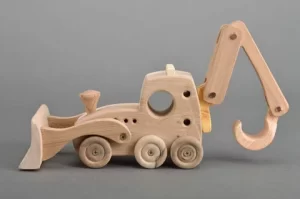The Magic of Wooden Toys: Nurturing Growth Through Play
As a child, I vividly remember the smooth texture of my favorite wooden blocks, their earthy scent, and the satisfying ‘clack’ as I stacked them high. Little did I know then that these simple toys were shaping my development in profound ways. Today, as we navigate a world of flashing screens and battery-operated gadgets, it’s time to rediscover the timeless appeal and benefits of wooden toys.

The Montessori Connection: Why Wood?
Maria Montessori, the pioneering educator, advocated for natural materials in children’s learning environments. Wooden toys, with their organic feel and durability, align perfectly with this philosophy. But what makes them so special?
- Natural Sensory Experience: wood toy engages multiple senses – touch, sight, and even smell – providing a rich, multisensory play experience.
- Durability and Sustainability: Unlike plastic alternatives, wooden toys can last for generations, making them both economical and eco-friendly.
- Simplicity Sparks Creativity: The minimalist design of many wooden toys encourages open-ended play and imaginative thinking.
Developmental Benefits: More Than Meets the Eye
Wooden toys aren’t just aesthetically pleasing; they’re powerful tools for child development. Let’s explore how:
1. Fine Motor Skills
Manipulating wooden puzzles, stacking blocks, or threading beads helps develop hand-eye coordination and fine motor skills. These skills are crucial for later activities like writing and using utensils.
2. Cognitive Development
Wooden toys often require problem-solving and spatial reasoning. A simple set of building blocks can become a complex engineering challenge, fostering critical thinking skills.
3. Social and Emotional Growth
Many wooden toys, like play kitchens or dollhouses, encourage role-play and social interaction. These activities help children develop empathy, communication skills, and emotional intelligence.
4. Concentration and Focus
The simplicity of wooden toys can lead to longer periods of engaged play, improving concentration and attention span – skills that are increasingly important in our distraction-filled world.
The Digital Dilemma: Finding Balance
In an age where screens dominate, some might argue that wooden toys are outdated. However, the tactile nature of these toys provides a crucial counterbalance to digital experiences. They offer a tangible, real-world interaction that screens simply can’t replicate.
That said, it’s not about completely eschewing technology, but rather finding a healthy balance. Wooden toys can complement digital learning, offering a hands-on dimension that enhances overall development.
Choosing the Right Wooden Toys
When selecting wooden toys, consider the following:
- Age-appropriateness: Ensure the toy matches your child’s developmental stage.
- Safety: Look for smooth edges and non-toxic finishes.
- Versatility: Opt for toys that can grow with your child and offer multiple play possibilities.
- Quality: Invest in well-made toys that will withstand years of play.
For a curated selection of high-quality wooden toys, you might want to explore Montessori Trove’s wooden toy collection. They offer a range of options that align with Montessori principles and support various aspects of child development.
Conclusion: Embracing the Wooden Toy Renaissance
As we look to the future of child development, it’s clear that sometimes the best path forward involves looking back. Wooden toys offer a timeless appeal that transcends generations, providing a foundation for learning that is as solid as the material itself.
In a world that often moves too fast, these simple playthings invite us to slow down, engage more deeply, and rediscover the joy of hands-on play. So the next time you’re considering a new toy for the little ones in your life, remember the magic that a well-crafted piece of wood can bring. It might just be the key to unlocking a world of imagination, growth, and endless possibilities.
What childhood memories do you have of wooden toys? How do you see them fitting into the lives of children today? Let’s continue this conversation and explore how we can best nurture the next generation through the power of play.
